A Modified Model for Quantitative Heavy Metal Source Apportionment and Pollution Pathway Identification
Abstract
1. Introduction
2. Materials and Methods
2.1. Overview of the Research Area
2.2. Sampling and Analysis
2.3. Model Hypothesis
2.4. Quantification of the Contribution of Soil Parent Material
2.5. Identification of Anthropogenic Sources and Their Potential Pathways with GPCA and GeoDetector
2.6. Quantification of the Contributions from Anthropogenic Emissions
2.7. Data Analysis
3. Results
3.1. The Statistical Analysis of Soil Heavy Metals and Quantification of Natural Sources
3.2. Analysis of Potential Pollution Sources by GPCA and Distributions of Factories
3.3. Analysis of Pollution Source Pathways Based on GeoDetector
3.4. The Quantification of Contribution from Anthropogenic Sources
3.5. Effect of Pollution Pathways on Heavy Metal Accumulation in Soil
4. Discussion
5. Conclusions
Supplementary Materials
Author Contributions
Funding
Institutional Review Board Statement
Informed Consent Statement
Data Availability Statement
Conflicts of Interest
References
- Shi, J.; Zhao, D.; Ren, F.; Huang, L. Spatiotemporal Variation of Soil Heavy Metals in China: The Pollution Status and Risk Assessment. Sci. Total Environ. 2023, 871, 161768. [Google Scholar] [CrossRef] [PubMed]
- Wang, C.-C.; Zhang, Q.-C.; Yan, C.-A.; Tang, G.-Y.; Zhang, M.-Y.; Ma, L.Q.; Gu, R.-H.; Xiang, P. Heavy Metal(Loid)s in Agriculture Soils, Rice, and Wheat across China: Status Assessment and Spatiotemporal Analysis. Sci. Total Environ. 2023, 882, 163361. [Google Scholar] [CrossRef] [PubMed]
- Hu, Y.; Cheng, H.; Tao, S. The Challenges and Solutions for Cadmium-Contaminated Rice in China: A Critical Review. Environ. Int. 2016, 92–93, 515–532. [Google Scholar] [CrossRef] [PubMed]
- Liu, Y.; Cui, J.; Peng, Y.; Lu, Y.; Yao, D.; Yang, J.; He, Y. Atmospheric Deposition of Hazardous Elements and Its Accumulation in Both Soil and Grain of Winter Wheat in a Lead-Zinc Smelter Contaminated Area, Central China. Sci. Total Environ. 2020, 707, 135789. [Google Scholar] [CrossRef] [PubMed]
- Huang, Y.; Li, T.; Wu, C.; He, Z.; Japenga, J.; Deng, M.; Yang, X. An Integrated Approach to Assess Heavy Metal Source Apportionment in Peri-Urban Agricultural Soils. J. Hazard. Mater. 2015, 299, 540–549. [Google Scholar] [CrossRef] [PubMed]
- Huang, Y.; Deng, M.; Wu, S.; Japenga, J.; Li, T.; Yang, X.; He, Z. A Modified Receptor Model for Source Apportionment of Heavy Metal Pollution in Soil. J. Hazard. Mater. 2018, 354, 161–169. [Google Scholar] [CrossRef] [PubMed]
- Zeng, W.; Wan, X.; Wang, L.; Lei, M.; Chen, T.; Gu, G. Apportionment and Location of Heavy Metal(Loid)s Pollution Sources for Soil and Dust Using the Combination of Principal Component Analysis, Geodetector, and Multiple Linear Regression of Distance. J. Hazard. Mater. 2022, 438, 129468. [Google Scholar] [CrossRef] [PubMed]
- Zhao, R.; Guan, Q.; Luo, H.; Lin, J.; Yang, L.; Wang, F.; Pan, N.; Yang, Y. Fuzzy Synthetic Evaluation and Health Risk Assessment Quantification of Heavy Metals in Zhangye Agricultural Soil from the Perspective of Sources. Sci. Total Environ. 2019, 697, 134126. [Google Scholar] [CrossRef]
- Chen, H.; Chai, M.; Cheng, J.; Wang, Y.; Tang, Z. Occurrence and Health Implications of Heavy Metals in Preschool Children’s Clothing Manufactured in Four Asian Regions. Ecotoxicol. Environ. Saf. 2022, 245, 114121. [Google Scholar] [CrossRef]
- Relić, D.; Sakan, S.; Anđelković, I.; Popović, A.; Đorđević, D. Pollution and Health Risk Assessments of Potentially Toxic Elements in Soil and Sediment Samples in a Petrochemical Industry and Surrounding Area. Molecules 2019, 24, 2139. [Google Scholar] [CrossRef]
- Adnan, M.; Xiao, B.; Xiao, P.; Zhao, P.; Li, R.; Bibi, S. Research Progress on Heavy Metals Pollution in the Soil of Smelting Sites in China. Toxics 2022, 10, 231. [Google Scholar] [CrossRef] [PubMed]
- Feng, W.; Guo, Z.; Xiao, X.; Peng, C.; Shi, L.; Ran, H.; Xu, W. Atmospheric Deposition as a Source of Cadmium and Lead to Soil-Rice System and Associated Risk Assessment. Ecotoxicol. Environ. Saf. 2019, 180, 160–167. [Google Scholar] [CrossRef] [PubMed]
- Krishna, A.K.; Satyanarayanan, M.; Govil, P.K. Assessment of Heavy Metal Pollution in Water Using Multivariate Statistical Techniques in an Industrial Area: A Case Study from Patancheru, Medak District, Andhra Pradesh, India. J. Hazard. Mater. 2009, 167, 366–373. [Google Scholar] [CrossRef] [PubMed]
- Yang, X.; Yang, Y.; Wan, Y.; Wu, R.; Feng, D.; Li, K. Source Identification and Comprehensive Apportionment of the Accumulation of Soil Heavy Metals by Integrating Pollution Landscapes, Pathways, and Receptors. Sci. Total Environ. 2021, 786, 147436. [Google Scholar] [CrossRef] [PubMed]
- Zhang, Z.; Lu, Y.; Li, H.; Tu, Y.; Liu, B.; Yang, Z. Assessment of Heavy Metal Contamination, Distribution and Source Identification in the Sediments from the Zijiang River, China. Sci. Total Environ. 2018, 645, 235–243. [Google Scholar] [CrossRef] [PubMed]
- Jafari, F.; Khademi, H. Spatial and Temporal Distribution of Heavy Metals Concentration in Atmospheric Dust in Kerman City. J. Environ. Stud. 2014, 40, 361–373. [Google Scholar] [CrossRef]
- Sobhanardakani, S. Ecological and Human Health Risk Assessment of Heavy Metal Content of Atmospheric Dry Deposition, a Case Study: Kermanshah, Iran. Biol Trace Elem Res 2019, 187, 602–610. [Google Scholar] [CrossRef] [PubMed]
- Zhu, Z.; Xu, Z.; Peng, J.; Fei, J.; Yu, P.; Wang, M.; Tan, Y.; Huang, Y.; Zhran, M.; Fahmy, A. The Contribution of Atmospheric Deposition of Cadmium and Lead to Their Accumulation in Rice Grains. Plant Soil 2022, 477, 373–387. [Google Scholar] [CrossRef]
- Liao, S.; Jin, G.; Khan, M.A.; Zhu, Y.; Duan, L.; Luo, W.; Jia, J.; Zhong, B.; Ma, J.; Ye, Z.; et al. The Quantitative Source Apportionment of Heavy Metals in Peri-Urban Agricultural Soils with UNMIX and Input Fluxes Analysis. Environ. Technol. Innov. 2021, 21, 101232. [Google Scholar] [CrossRef]
- Zhou, Y.; Jiang, D.; Ding, D.; Wu, Y.; Wei, J.; Kong, L.; Long, T.; Fan, T.; Deng, S. Ecological-Health Risks Assessment and Source Apportionment of Heavy Metals in Agricultural Soils around a Super-Sized Lead-Zinc Smelter with a Long Production History, in China. Environ. Pollut. 2022, 307, 119487. [Google Scholar] [CrossRef]
- Zhou, J.; Du, B.; Liu, H.; Cui, H.; Zhang, W.; Fan, X.; Cui, J.; Zhou, J. The Bioavailability and Contribution of the Newly Deposited Heavy Metals (Copper and Lead) from Atmosphere to Rice (Oryza sativa L.). J. Hazard. Mater. 2020, 384, 121285. [Google Scholar] [CrossRef] [PubMed]
- Azimi, S.; Cambier, P.; Lecuyer, I.; Thevenot, D. Heavy Metal Determination in Atmospheric Deposition and Other Fluxes in Northern France Agrosystems. Water Air Soil Pollut. 2004, 157, 295–313. [Google Scholar] [CrossRef]
- Nicholson, F.A.; Smith, S.R.; Alloway, B.J.; Carlton-Smith, C.; Chambers, B.J. An Inventory of Heavy Metals Inputs to Agricultural Soils in England and Wales. Sci. Total Environ. 2003, 311, 205–219. [Google Scholar] [CrossRef] [PubMed]
- Zhang, Y.; Zhang, S.; Zhu, F.; Wang, A.; Dai, H.; Cheng, S.; Wang, J.; Tang, L. Atmospheric Heavy Metal Deposition in Agro-Ecosystems in China. Environ. Sci. Pollut. Res. 2018, 25, 5822–5831. [Google Scholar] [CrossRef] [PubMed]
- Yi, K.; Fan, W.; Chen, J.; Jiang, S.; Huang, S.; Peng, L.; Zeng, Q.; Luo, S. Annual Input and Output Fluxes of Heavy Metals to Paddy Fields in Four Types of Contaminated Areas in Hunan Province, China. Sci. Total Environ. 2018, 634, 67–76. [Google Scholar] [CrossRef]
- Yu, E.; Liu, H.; Tu, Y.; Gu, X.; Ran, X.; Yu, Z.; Wu, P. Superposition Effects of Zinc Smelting Atmospheric Deposition on Soil Heavy Metal Pollution Under Geochemical Anomaly. Front. Environ. Sci. 2022, 10, 777894. [Google Scholar] [CrossRef]
- Al-Khashman, O.A.; Shawabkeh, R.A. Metals Distribution in Soils around the Cement Factory in Southern Jordan. Environ. Pollut. 2006, 140, 387–394. [Google Scholar] [CrossRef]
- Hua, S.; Tian, H.; Wang, K.; Zhu, C.; Gao, J.; Ma, Y.; Xue, Y.; Wang, Y.; Duan, S.; Zhou, J. Atmospheric Emission Inventory of Hazardous Air Pollutants from China’s Cement Plants: Temporal Trends, Spatial Variation Characteristics and Scenario Projections. Atmos. Environ. 2016, 128, 1–9. [Google Scholar] [CrossRef]
- Cao, X.; Zhang, X.; Tong, D.Q.; Chen, W.; Zhang, S.; Zhao, H.; Xiu, A. Review on Physicochemical Properties of Pollutants Released from Fireworks: Environmental and Health Effects and Prevention. Environ. Rev. 2018, 26, 133–155. [Google Scholar] [CrossRef]
- Liu, Y.; Huang, H.; Sun, T.; Yuan, Y.; Pan, Y.; Xie, Y.; Fan, Z.; Wang, X. Comprehensive Risk Assessment and Source Apportionment of Heavy Metal Contamination in the Surface Sediment of the Yangtze River Anqing Section, China. Environ. Earth Sci. 2018, 77, 493. [Google Scholar] [CrossRef]
- Chen, Y.-F.; Shi, Q.-Y.; Qu, J.-Y.; He, M.-X.; Liu, Q. A Pollution Risk Assessment and Source Analysis of Heavy Metals in Sediments: A Case Study of Lake Gehu, China. Chin. J. Anal. Chem. 2022, 50, 100077. [Google Scholar] [CrossRef]
- Sanyal, T.; Kaviraj, A.; Saha, S. Deposition of Chromium in Aquatic Ecosystem from Effluents of Handloom Textile Industries in Ranaghat–Fulia Region of West Bengal, India. J. Adv. Res. 2015, 6, 995–1002. [Google Scholar] [CrossRef]
- Ahsan, M.A.; Satter, F.; Siddique, M.A.B.; Akbor, M.A.; Ahmed, S.; Shajahan, M.; Khan, R. Chemical and Physicochemical Characterization of Effluents from the Tanning and Textile Industries in Bangladesh with Multivariate Statistical Approach. Environ. Monit. Assess. 2019, 191, 575. [Google Scholar] [CrossRef] [PubMed]
- Qiang, L.; Yang, W.; Jingshuang, L.; Quanying, W.; Mingying, Z. Grain-Size Distribution and Heavy Metal Contamination of Road Dusts in Urban Parks and Squares in Changchun, China. Environ. Geochem. Health 2015, 37, 71–82. [Google Scholar] [CrossRef] [PubMed]
- Yan, G.; Mao, L.; Jiang, B.; Chen, X.; Gao, Y.; Chen, C.; Li, F.; Chen, L. The Source Apportionment, Pollution Characteristic and Mobility of Sb in Roadside Soils Affected by Traffic and Industrial Activities. J. Hazard. Mater. 2020, 384, 121352. [Google Scholar] [CrossRef]
- Yuan, Z.; Luo, T.; Liu, X.; Hua, H.; Zhuang, Y.; Zhang, X.; Zhang, L.; Zhang, Y.; Xu, W.; Ren, J. Tracing Anthropogenic Cadmium Emissions: From Sources to Pollution. Sci. Total Environ. 2019, 676, 87–96. [Google Scholar] [CrossRef] [PubMed]
- Liu, P.; Wu, Q.; Hu, W.; Tian, K.; Huang, B.; Zhao, Y. Effects of Atmospheric Deposition on Heavy Metals Accumulation in Agricultural Soils: Evidence from Field Monitoring and Pb Isotope Analysis. Environ. Pollut. 2023, 330, 121740. [Google Scholar] [CrossRef] [PubMed]
- Wang, J.; Li, X.; Christakos, G.; Liao, Y.; Zhang, T.; Gu, X.; Zheng, X. Geographical Detectors-Based Health Risk Assessment and Its Application in the Neural Tube Defects Study of the Heshun Region, China. Int. J. Geogr. Inf. Sci. 2010, 24, 107–127. [Google Scholar] [CrossRef]
- Su, Y.; Li, T.; Cheng, S.; Wang, X. Spatial Distribution Exploration and Driving Factor Identification for Soil Salinisation Based on Geodetector Models in Coastal Area. Ecol. Eng. 2020, 156, 105961. [Google Scholar] [CrossRef]
- Huang, S.; Xiao, L.; Zhang, Y.; Wang, L.; Tang, L. Interactive Effects of Natural and Anthropogenic Factors on Heterogenetic Accumulations of Heavy Metals in Surface Soils through Geodetector Analysis. Sci. Total Environ. 2021, 789, 147937. [Google Scholar] [CrossRef]
- Tao, H.; Liao, X.; Li, Y.; Xu, C.; Zhu, G.; Cassidy, D.P. Quantifying Influences of Interacting Anthropogenic-Natural Factors on Trace Element Accumulation and Pollution Risk in Karst Soil. Sci. Total Environ. 2020, 721, 137770. [Google Scholar] [CrossRef]
- Kaiser, H.F. The Application of Electronic Computers to Factor Analysis. Educ. Psychol. Meas. 1960, 20, 141–151. [Google Scholar] [CrossRef]
- Guan, Q.; Wang, F.; Xu, C.; Pan, N.; Lin, J.; Zhao, R.; Yang, Y.; Luo, H. Source Apportionment of Heavy Metals in Agricultural Soil Based on PMF: A Case Study in Hexi Corridor, Northwest China. Chemosphere 2018, 193, 189–197. [Google Scholar] [CrossRef]
- Chen, Z.; Ding, Y.; Jiang, X.; Duan, H.; Ruan, X.; Li, Z.; Li, Y. Combination of UNMIX, PMF Model and Pb-Zn-Cu Isotopic Compositions for Quantitative Source Apportionment of Heavy Metals in Suburban Agricultural Soils. Ecotoxicol. Environ. Saf. 2022, 234, 113369. [Google Scholar] [CrossRef] [PubMed]
- Su, C.; Meng, J.; Zhou, Y.; Bi, R.; Chen, Z.; Diao, J.; Huang, Z.; Kan, Z.; Wang, T. Heavy Metals in Soils from Intense Industrial Areas in South China: Spatial Distribution, Source Apportionment, and Risk Assessment. Front. Environ. Sci. 2022, 10, 820536. [Google Scholar] [CrossRef]
- Sun, Y.; Zhuang, G.; Zhang, W.; Wang, Y.; Zhuang, Y. Characteristics and Sources of Lead Pollution after Phasing out Leaded Gasoline in Beijing. Atmos. Environ. 2006, 40, 2973–2985. [Google Scholar] [CrossRef]
- Chanchpara, A.; Muduli, M.; Prabhakar, V.; Madhava, A.K.; Thorat, R.B.; Haldar, S.; Ray, S. Pre-to-Post Diwali Air Quality Assessment and Particulate Matter Characterization of a Western Coastal Place in India. Environ. Monit. Assess. 2023, 195, 413. [Google Scholar] [CrossRef] [PubMed]
- Zhang, P.; Qin, C.; Hong, X.; Kang, G.; Qin, M.; Yang, D.; Pang, B.; Li, Y.; He, J.; Dick, R.P. Risk Assessment and Source Analysis of Soil Heavy Metal Pollution from Lower Reaches of Yellow River Irrigation in China. Sci. Total Environ. 2018, 633, 1136–1147. [Google Scholar] [CrossRef]
- Qiao, P.; Lei, M.; Yang, S.; Yang, J.; Guo, G.; Zhou, X. Comparing Ordinary Kriging and Inverse Distance Weighting for Soil as Pollution in Beijing. Environ. Sci. Pollut. Res. 2018, 25, 15597–15608. [Google Scholar] [CrossRef]
- Huaiwei, Z.; Xin, H. An Overview for the Utilization of Wastes from Stainless Steel Industries. Resour. Conserv. Recycl. 2011, 55, 745–754. [Google Scholar] [CrossRef]
- Bhuiyan, M.A.H.; Parvez, L.; Islam, M.A.; Dampare, S.B.; Suzuki, S. Heavy Metal Pollution of Coal Mine-Affected Agricultural Soils in the Northern Part of Bangladesh. J. Hazard. Mater. 2010, 173, 384–392. [Google Scholar] [CrossRef] [PubMed]
- Luo, Y.; Shi, C.; Yang, S.; Liu, Y.; Zhao, S.; Zhang, C. Characteristics of Soil Calcium Content Distribution in Karst Dry-Hot Valley and Its Influencing Factors. Water 2023, 15, 1119. [Google Scholar] [CrossRef]
- Dung, T.T.T.; Cappuyns, V.; Swennen, R.; Phung, N.K. From Geochemical Background Determination to Pollution Assessment of Heavy Metals in Sediments and Soils. Rev. Environ. Sci. Biotechnol. 2013, 12, 335–353. [Google Scholar] [CrossRef]
- Bilińska, L.; Gmurek, M.; Ledakowicz, S. Comparison between Industrial and Simulated Textile Wastewater Treatment by AOPs—Biodegradability, Toxicity and Cost Assessment. Chem. Eng. J. 2016, 306, 550–559. [Google Scholar] [CrossRef]
- Berthiaume, A.; Monette, A.; Rosenberger, J.; Lupien, B. Comment on Giacosa et al. Characterization of Annual Air Emissions Reported by Pulp and Paper Mills in Atlantic Canada. Pollutants 2022, 2, 135–155. Pollutants 2022, 2, 328–329. [Google Scholar] [CrossRef]
- Liu, Z.; Fei, Y.; Shi, H.; Mo, L.; Qi, J. Prediction of High-Risk Areas of Soil Heavy Metal Pollution with Multiple Factors on a Large Scale in Industrial Agglomeration Areas. Sci. Total Environ. 2022, 808, 151874. [Google Scholar] [CrossRef]
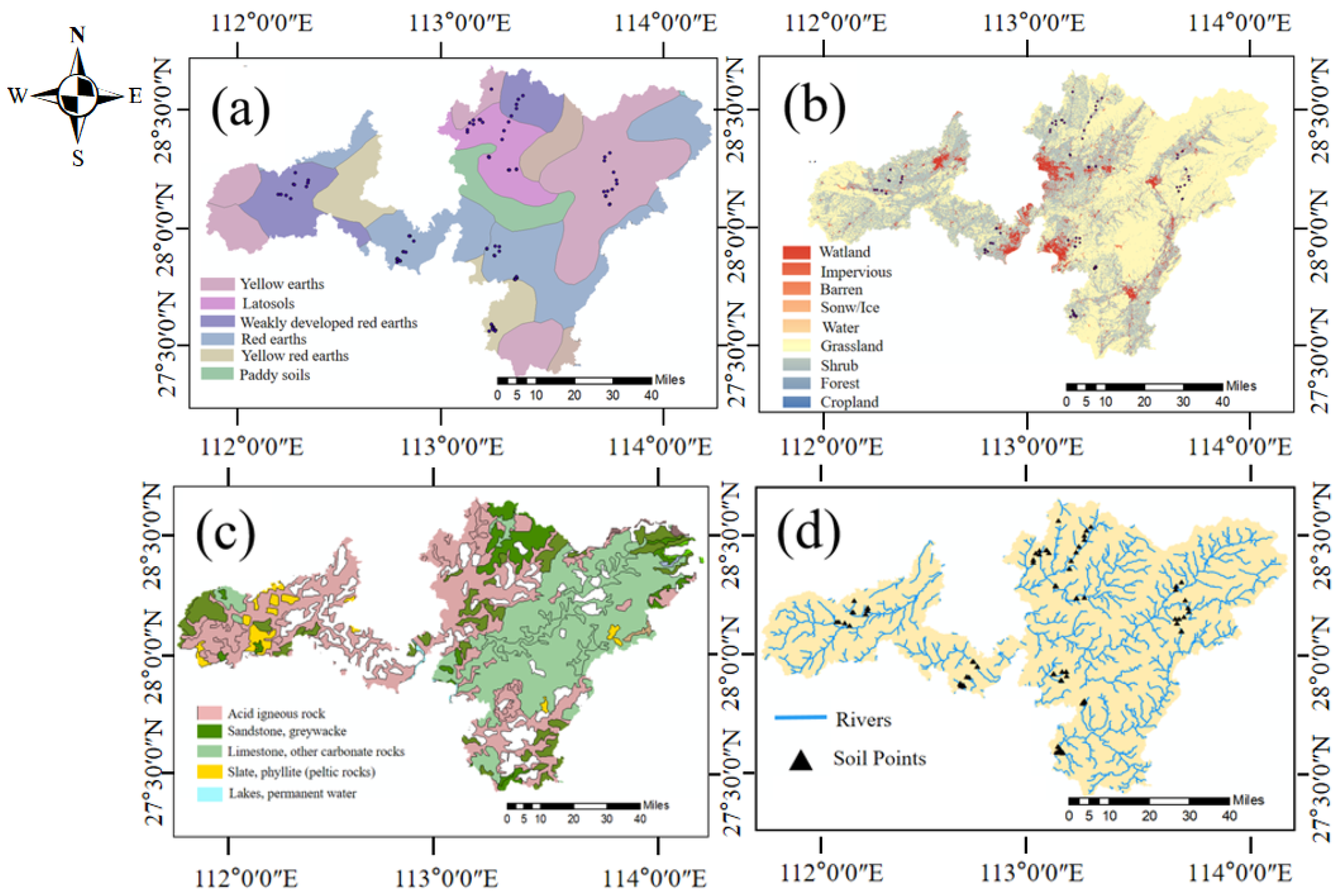
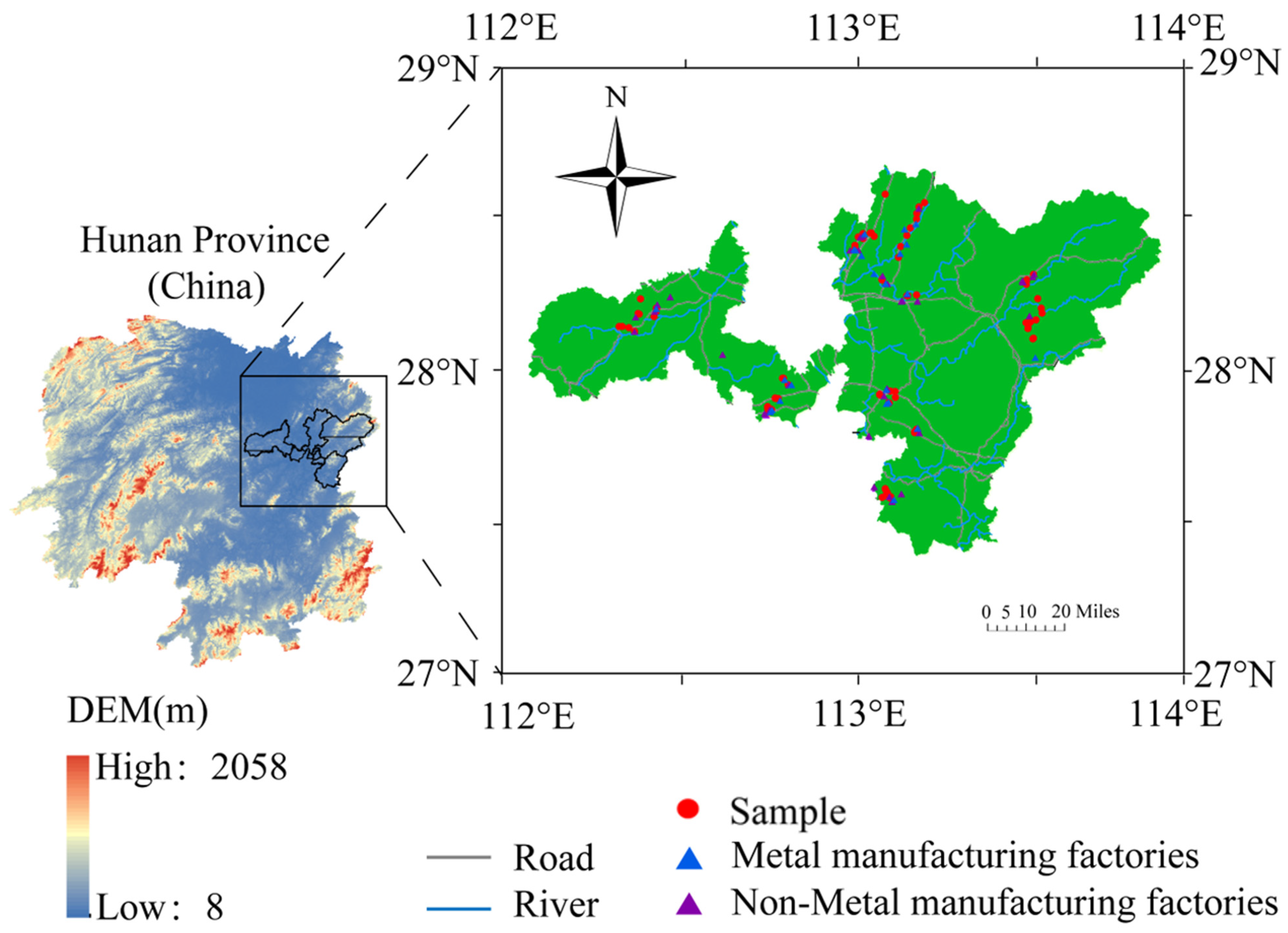
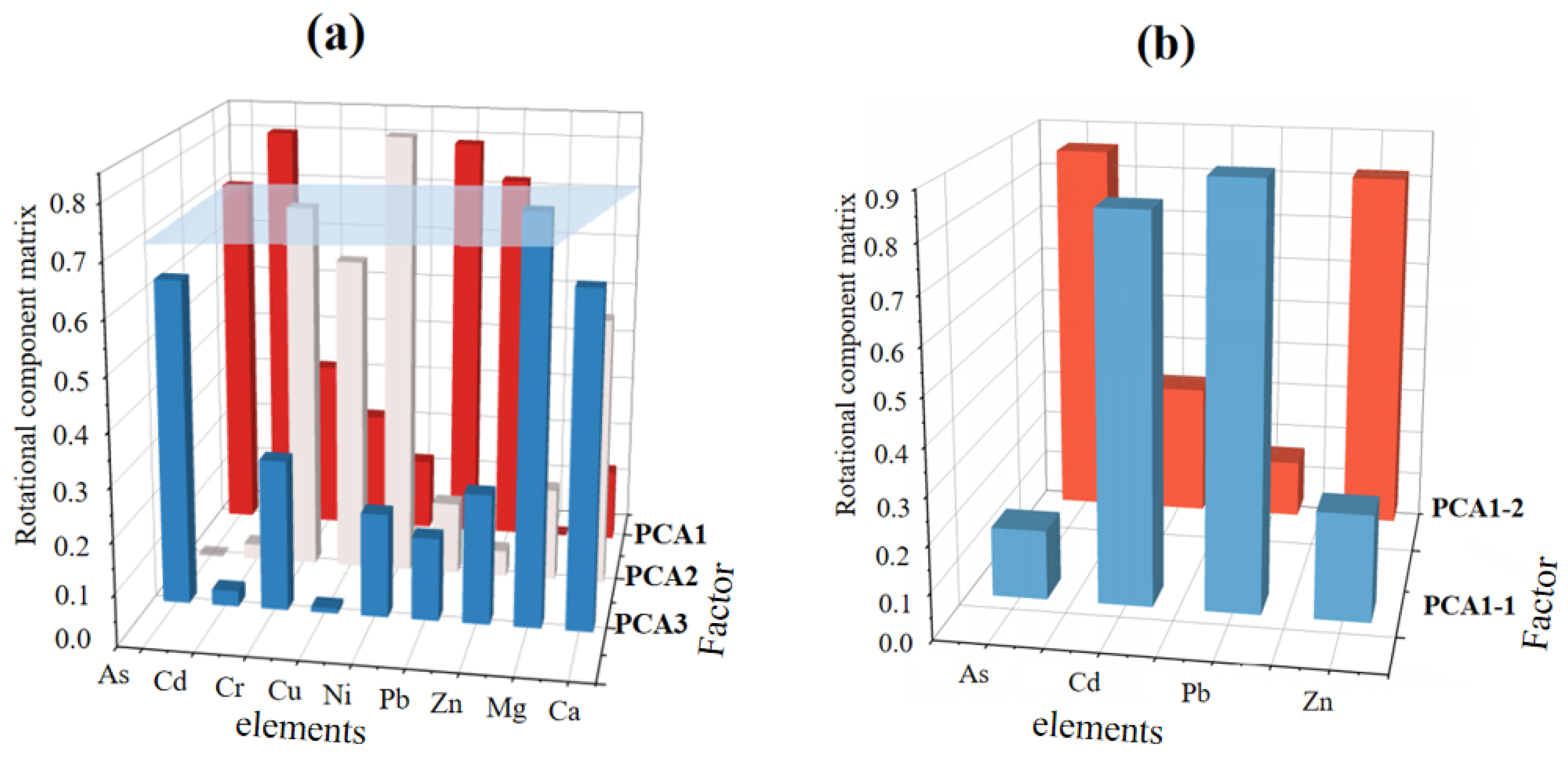
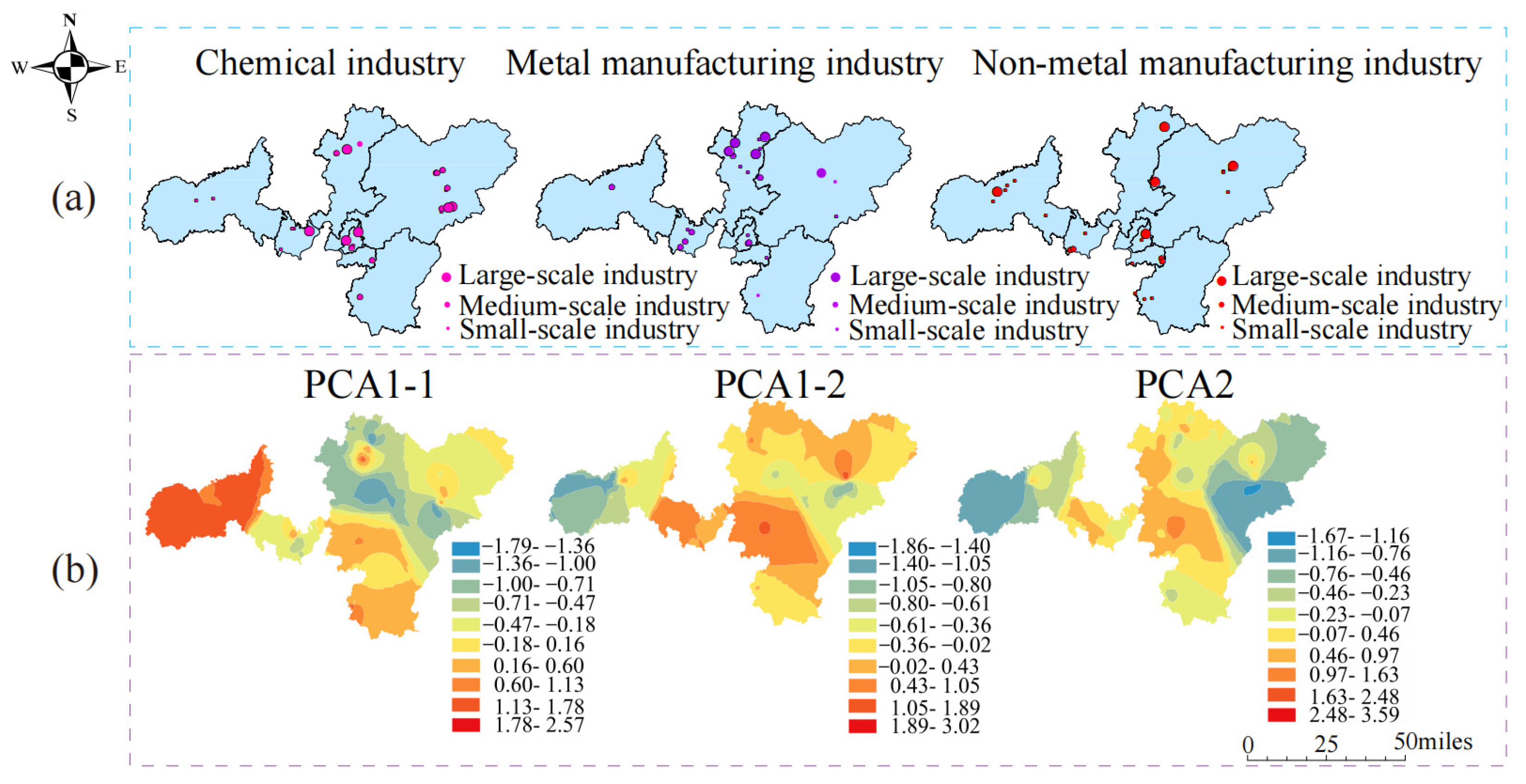

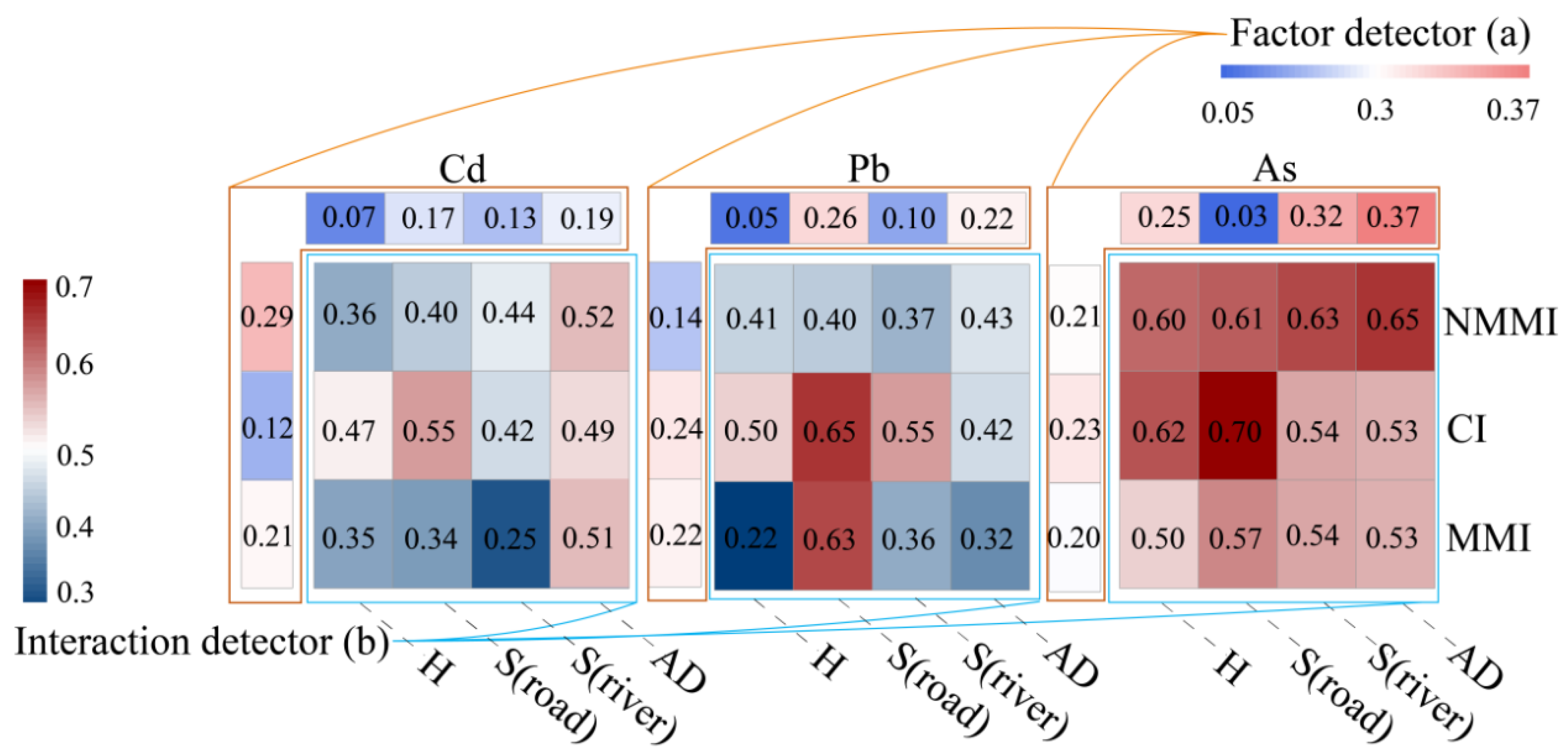

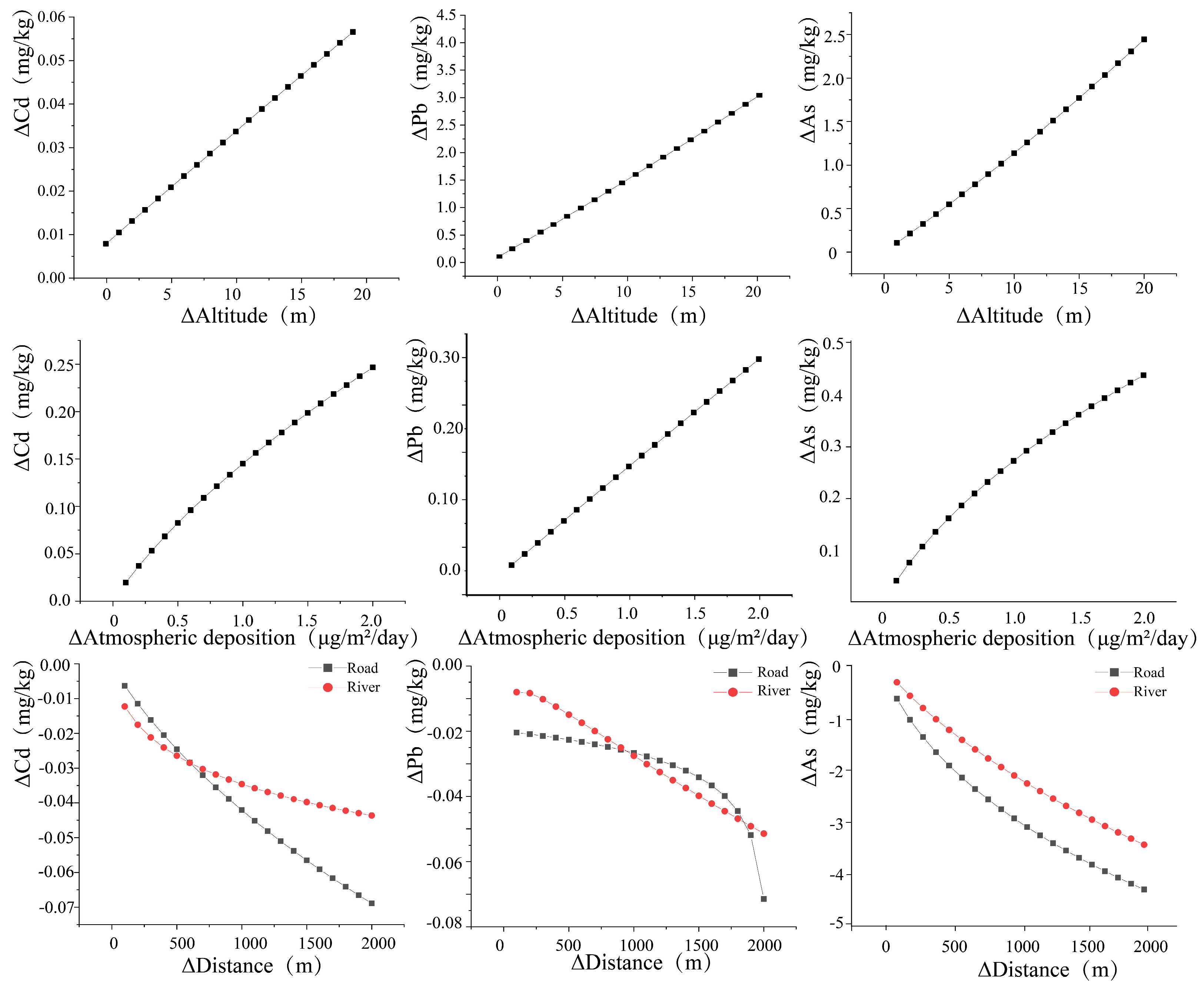
| Element | As | Cd | Cr | Cu | Ni | Pb | Zn | Ca | Mg |
|---|---|---|---|---|---|---|---|---|---|
| Minimum (mg/kg) | 5.85 | 0.20 | 16.33 | 13.33 | 10.78 | 17.85 | 73.48 | 642.73 | 2662.55 |
| Median (mg/kg) | 26.72 | 0.54 | 81.89 | 27.42 | 27.8 | 40.35 | 131.97 | 1254.23 | 4444.38 |
| Maximum (mg/kg) | 83.81 | 2.48 | 219.75 | 65.46 | 71.95 | 95.85 | 305.63 | 5966.32 | 10,447.30 |
| Mean (mg/kg) | 26.47 | 0.70 | 87.07 | 29.37 | 28.41 | 43.94 | 133.78 | 1471.28 | 4600.78 |
| Skewness | 1.04 | 1.38 | 1.07 | 1.34 | 1.47 | 0.93 | 1.13 | 2.84 | 1.53 |
| Kurtosis | 2.21 | 2.69 | 1.42 | 2.57 | 5.19 | 0.84 | 3.86 | 10.84 | 3.85 |
| SD a | 13.57 | 0.40 | 36.61 | 9.98 | 8.98 | 15.63 | 35.9 | 851.34 | 1323.58 |
| CV% b | 51.27 | 57.21 | 42.05 | 33.99 | 31.59 | 35.57 | 26.83 | 57.86 | 28.77 |
| Risk screening (mg/kg) | 40.00 | 0.30 | 150.00 | 50.00 | 60.00 | 70.00 | 200.00 | - | - |
| Background c (mg/kg) | 12.80 | 0.14 | 150.00 | 25.00 | 27.80 | 30.00 | 84.20 | 1300.00 | 4000.00 |
| Excess rate d | 16% | 90% | 8% | 5% | 2% | 9% | 5% | - | - |
| Element | NMMI | CI | MMI | Soil Parent Material | |
|---|---|---|---|---|---|
| Model 1 | Cd | 25% | 19% | 33% | 23% |
| As | 17% | 24% | 42% | 17% | |
| Pb | 13% | 24% | 17% | 46% | |
| Model 2 | Cd | 28% | 12% | 44% | 16% |
| As | 11% | 14% | 61% | 14% | |
| Pb | 1% | 17% | 21% | 61% | |
| Model 3 | Cd | 35% | 20% | 30% | 15% |
| As | 10% | 11% | 58% | 22% | |
| Pb | 7% | 24% | 32% | 37% | |
| Model 4 | Cd | 54% | 1% | 8% | 37% |
| As | 33% | 47% | 17% | 3% | |
| Pb | 17% | 32% | 41% | 10% | |
| Range (Models 1, 2, 3) | Cd | 25–35% | 12–20% | 30–44% | 16–23% |
| As | 10–17% | 11–24% | 42–58% | 14–22% | |
| Pb | 1–13% | 17–24% | 17–32% | 37–61% |
Disclaimer/Publisher’s Note: The statements, opinions and data contained in all publications are solely those of the individual author(s) and contributor(s) and not of MDPI and/or the editor(s). MDPI and/or the editor(s) disclaim responsibility for any injury to people or property resulting from any ideas, methods, instructions or products referred to in the content. |
© 2024 by the authors. Licensee MDPI, Basel, Switzerland. This article is an open access article distributed under the terms and conditions of the Creative Commons Attribution (CC BY) license (https://creativecommons.org/licenses/by/4.0/).
Share and Cite
Wang, M.; Yu, P.; Tong, Z.; Shao, X.; Peng, J.; Hamid, Y.; Huang, Y. A Modified Model for Quantitative Heavy Metal Source Apportionment and Pollution Pathway Identification. Toxics 2024, 12, 382. https://doi.org/10.3390/toxics12060382
Wang M, Yu P, Tong Z, Shao X, Peng J, Hamid Y, Huang Y. A Modified Model for Quantitative Heavy Metal Source Apportionment and Pollution Pathway Identification. Toxics. 2024; 12(6):382. https://doi.org/10.3390/toxics12060382
Chicago/Turabian StyleWang, Maodi, Pengyue Yu, Zhenglong Tong, Xingyuan Shao, Jianwei Peng, Yasir Hamid, and Ying Huang. 2024. "A Modified Model for Quantitative Heavy Metal Source Apportionment and Pollution Pathway Identification" Toxics 12, no. 6: 382. https://doi.org/10.3390/toxics12060382
APA StyleWang, M., Yu, P., Tong, Z., Shao, X., Peng, J., Hamid, Y., & Huang, Y. (2024). A Modified Model for Quantitative Heavy Metal Source Apportionment and Pollution Pathway Identification. Toxics, 12(6), 382. https://doi.org/10.3390/toxics12060382








